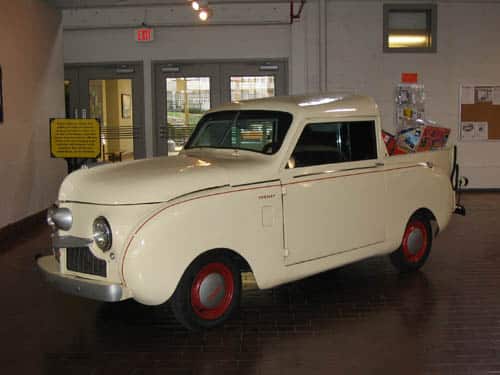
Crosley CC4 Pickup- 1948
Probably the most advanced automobile manufacturer in America during the post-WWII years was Crosley, a radio and refrigerator manufacturer. They pioneered the production of quality small cars for a...
DAILY DEMONSTRATIONS AT 11AM, FREE WITH ADMISSION!
Please note that the cars or exhibit items shown in this database are part of our collection but may not be on display when you visit.
Probably the most advanced automobile manufacturer in America during the post-WWII years was Crosley, a radio and refrigerator manufacturer. They pioneered the production of quality small cars for a...
Powell Crosley, Jr. is famous for making millions by producing Crosley radios and Shelvador refrigerators. Mr. Crosley also had a passion for cars, and believed America was ready for...
The Farm•O•Road was in keeping with Crosley’s philosophy of offering minimum cost vehicles. It has a wheelbase of only 63 inches and an overall length of 91.5 inches. Crosley aimed...
During World War II, American soldiers assigned overseas were introduced to the thrill of spritely open roadsters. It wasn’t long before American automotive manufacturers turned their attention to the...
In March 1957, this minimalist vehicle, first introduced as the Cyclops Two appeared in the pages of Road & Track (R&T). It was seen in the form of a...
D.A.F. is a Dutch company that began in the late 1920s as a garage. After WWII, the company started manufacturing commercial vehicles. The economical situation and the success of...
By Bob May III To truly appreciate the character of this 1969 Daihatsu Trimobile you have to understand the character of its ownership lineage. I came to own the...
In the early 1920’s, Gaston Daix, a highly-skilled piano maker with a factory in Pessac, near Bordeaux in the south of France, made this unusual ark-like pedal car with...
Otto Daus was one of those rare individuals that not only decided he could build his own car, he actually did it. Otto actually started out by building...
Charismatic used cars salesman Glen Gordon “Gary” Davis moved from Indiana to Southern California filled with optimism and dreams. On the streets of Los Angeles, he saw an aerospace-styled...
Glenn Gordan “Gary” Davis was an industrial designer and salesman. Around the end of World War II, he bought a small racecar that a California racing enthusiast had...
Mark Brinker is an automotive enthusiast, collector, historian, and racer. His interests are wide and varied and for many years he has been particularly fascinated by the machines built...
René Bonnet was a self-made engineer with a passion for competition and Charles Deutsch was a trained body designer who managed a custom coach works in Champigny-sur-Marne, close to...
After having great success in GT and sports car racing, two of the great race car builders in France, Charles Deutsch and Rene Bonnet, developed the Monomill series of...
Bill Devin was an innovative car designer from Fontana, California. He began as a Chrysler-Plymouth dealer and moved up to exotic cars. He was also an accomplished racer and...
Bill Devin, aka “The Enzo Ferrari of Okie Flats”, grew up around cars – his family owned a Chevrolet dealership – and he and his brother opened a...
This 1963 DKW F12 certainly doesn’t look like a production F12 due to its custom fiberglass sports car body. The original owner of this car designed his own sports...
DKW started as a motorcycle manufacturer in 1919. Their first motorcycles were called Das Kleiner Wunder (the little wonder); hence the name DKW. The motorcycle business was very successful,...
From 1949 to 1962, DKW produced a van with a trailing-arm rear suspension system which incorporated springs in the cross bar assembly. It had a very modern layout with...
Established in 1916 by Jørgen Skafte Rasmussen, DKW initially specialized in steam fittings before transitioning to being an early producer of two-stroke motorcycles in the 1920s. By the 1930s,...
The DKW-Vemag is considered the first genuinely Brazilian-made passenger vehicle. It is basically a German DKW Sonderklasse. There were some differences; for example, no heater was provided (for obvious...
The Dodge Viper was conceived as a futuristic interpretation of a classic American muscle car. During the development stage, it was decided to utilize Lamborghini, then a Chrysler subsidiary,...
Almost as a hobby, in 1977 Guy Duport built a prototype, first-of-its-kind diesel-powered microcar. It was a small car with a plastic body and 2 doors, equipped with a...
Buckminster Fuller had a long and productive career. He was a visionary that worked in many fields, from the environment to architecture. The Dymaxion, which is an acronym for...
The Elcar was a small electric car produced by the famous Italian design and coachbuilding company, Zagato. Known for designs such as the Ferrari 250 GT, Alfa Romeo TZ3...
The Enfield 8000 was created on the Isle of Wight by the Enfield company, owned by Greek shipping tycoon Giannis Goulandris. The Enfield had its roots in marine engine...